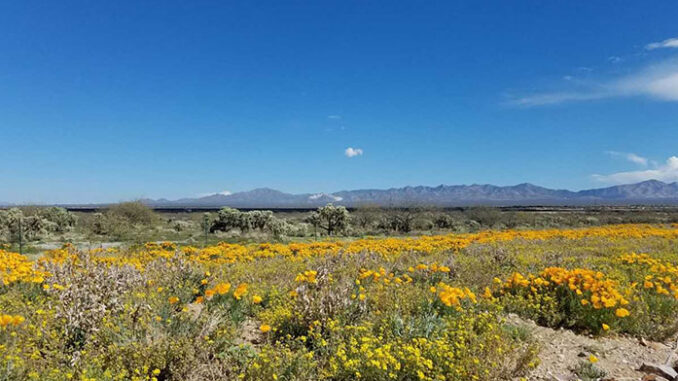
Story and photos by Emmalee Mauldin
This year’s superbloom in southern Arizona was a bright and colorful sight that will soon be fading into the glare of summer.
With rains late in the winter season and cooler temperatures continuing through the winter, wildflowers thrived throughout the region from March to April.
“We’ve had more flowers this year than in many years past,” said Andy Fisher, the chief of interpretation and education at Saguaro National Park.
A superbloom is a phenomenon that happens in the desert where an unusually high number of wildflowers blossom in the landscape.
One of the most famous wildflower superbloom locations in the United States is in California, at the Carrizo Plain National Monument in San Luis Obispo County. While Arizona’s wildflower’s might not have been to the level of California’s superbloom, there were still more blooms in the region than normal.
“We did see a superbloom in that we had swaths of bright orange poppies and purple lupine in there, and it was just the best we have seen probably in about 15 years,” said Michelle Thompson, the public information officer at the Arizona State Parks and Trails.

Wildflower season and superblooms aremostly caused by a series of weather events from the previous two seasons.
“It has to do with the fact that we had a really, really wet fall and winter, and then cool temperatures lasted longer into the year,” Thompson said. “So keeping the temperatures cool and seeing rain as late as March was part of what contributed to it.”
However, rain and cool temperatures are not the only contributors to the large wildflower blooms.
“Climate is variable so some years when there’s not a lot of rain, there’s not a lot of flowers. But it’s more than just those factors,” said George Ferguson from the University of Arizona herbarium. “Temperature has a big play in it and how hard it freezes. The amount of seeds that are in the ground already from previous years can have a big effect, especially if there haven’t been any seeds for a really long time. Then the seed bank is smaller. Even if it’s been a good winter, you might not see many flowers. So, it’s a combination of all of those events to make it a special event.”

But despite the higher numbers of blossoms in the region, many question whether this wildflower season could have been called a superbloom.
“The last couple of winters have been so dry that we’d almost forgotten what a normal wildflower season looks like, but I don’t know if this qualifies as a superbloom,” Fisher said.
With the bright explosion of color in the desert, it attracted many tourists and much media coverage.
“We had immediate interest in terms of reporters going out to the park and getting video and photography,” Thompson said.
“We’ve definitely received some extra media coverage because of the superbloom and we’ve heard of larger crowds at places like Saguaro National Park,” said Dan Gibson, director of communications at Visit Tucson. “It’s likely that the bloom has encouraged some people – locals and tourists – to get out to the incredible parks surrounding Tucson for the first time. Catalina State Park, for example, is such a great asset to our community, but it’s still under-appreciated to some extent
Thompson said Picacho Peak State Park had triple the number of visitors at the park on weekends. And for Saguaro National Park, Fisher said that for the first time, the park had to put out a notice to visitors explaining that if they plan on visiting the park, they should try to get there before 10 a.m. because there could be lines and full parking lots.

“We’re trying to communicate to visitors to, ‘Hey bring your patience,’ and get here as early as you can, because we can’t guarantee that you can get to where you want to go,” Fisher said.
With increased visitors at Arizona state parks, and horror stories of swarms of photo-snapping visitors trampling the superblooms in California in mind, there were fears of visitors ruining the flowers. However, there were minimal impacts in Arizona.
“I don’t know that we’re seeing a ton of impact on the blossoms and wildlife. I don’t know that we’re seeing any impacts in a negative way – we’re just busier,” Fisher said.
The same is true for the wildflowers in Saguaro National Park.
“For the most part, visitors were really respectful and they just enjoyed being out there, being able to see the flowers, without trampling or ruining them in any way,” Thompson said.

With wildflower season nearly over, it is time for the native desert cacti to begin their blooming season.
“We’re thankful that people get an opportunity to see the wonders of the Sonoran Desert the colors, the beauty for certain,” Gibson said.
